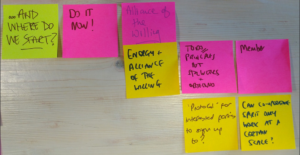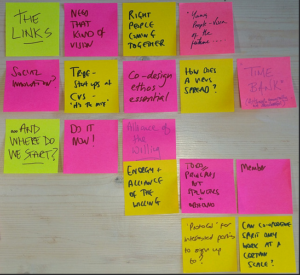
2nd August 2018
One of the idea ideas emerging from the public discussions during the Festival of York was a ‘community made through exchange’. We’ve been running events to follow up and develop these ideas. On 2nd August we explored this question through looking at a variety of different approaches to community-led economic development and then discussing and make a plan for what this might mean for York Central.
Mora Scaife, City of York Council
Mora introduced her work as part of the 4CommunityGrowthYork project. The project is underpinned by the idea of ‘small steps and being hyper-local’ and connects into the
‘asset-based’ approach the council is using city-wide.
• Mora gave the specific example of Chapelfields Community Association. A group of local people were interested in developing a Community Hub.
• Mora talked about how important it is to get conversations started and that she finds fig roles and garibaldis get conversations started immediately! People love them or hate them or remember names given to them by their parents or grandparents (e.g. squashed fly biscuits). But then the conversation gets deeper. Someone might say ‘I can’t have them because I’ve got diabetes’, then it can move into a well-being discussion and then Mora is able to lever in other council services. (e.g. linking in with Local Area Coordinators).
• But as Mora put it ‘it is not just the services that wrapround there, it’s the community’.
• Mora also noted that ‘activity breeds activity. Now lots of people now want to use the centre’ and ‘services and people have to link together – you can’t do anything is isolation’. ‘We can use that ethos, bringing things together, all the parts that are helpful in building communities’.
Imelda Havers, Red Tower and Bluefish regeneration
Imelda introduced her work with Red Tower and ideas and approaches based on her work in community-led regeneration. Imelda explained the way in which the Red Tower has been reinvented bottom up as a social enterprise serving local communities. Red Tower is owned by city of York Council but the Red Tower Community Interest Company has a 30 years lease. Red Tower recently won the Community category at the York Design awards.
• CYC-owned C15 building, empty for decades on City Walls
• Taken over by local group for pop-up cafes and informal events on PAYF basis
• In space of 3 years got funding, took 30-year lease, did refit and won award at York Design Awards for making “significant contribution to local community”
• Now volunteer run as Community Interest Company, having been designed and led by local communities
• Uses embrace Community (hunger café, local group use); Visitor (Heritage Open Days, York Walls Festival) and Commercial (meeting room hire)
• Benefits: Local service delivery which is financially viable. Supports CYC’s local delivery aspirations while not costing money in longer term; part of a growing network of community enterprises across the City “more than the sum of our parts”
Important lessons from this and other community projects
• Need “alliance of the willing” to drive real change (e.g. Incredible Edible; Real Junk Food Project; Transition Towns)
• Great to focus on what is possible but we need more than ideas – we need the structures to make sure that action follows
• Need financial and other resources to ensure there is the time and expertise for community input
• Governance is critical for success, so choose the right structure depending on what you want to do e.g CIC / Industrial & Provident Society / Community Land Trust / CIO / Development Trust / Charity
• Can use powers through 2011 Localism Act e.g. Community Right to Bid or Community Asset Transfer, to take control of local buildings or spaces from public sector
York Central
• Community needs a seat around the table at partnership
• Needs to work at two levels – Strategic (overall development of York Central)
• Operational (managing and running specific areas such as open space, social enterprise space, co-operative housing)
• Could open up York Central Community Forum as starting point for organisational approach
• Will need to set up a co-operative venture and / or social enterprise structure BUT keep it simple!
• Partners need to understand benefits of community involvement e.g. Low-cost expertise; Local intelligence; Local buy-in and credibility; Collaborative funding opportunities such as crowd funding, local investment fund, bids to funders who only fund community groups or charities
• Case for a “Community Champion”? ‘We are not going to go away, we will stay and fight our corner’.
Richard Norton, Headingley Development Trust, Leeds
Richard introduced the work of the Headingley Development Trust.
• Headingley is famous for sport and students. Headingley Development Trust (HDT) was a bottom up initiative to address changes to the neighbourhood that came about due to housing being bought up by private landlords and the retail offer was being more narrowly focused on the interests of young people. These were big challenges. Headingley is not a poor community but neither is it the wealthiest and it did not have access to targeted regenerations funds.
HEART
• The primary school slated for closure. ‘We didn’t want it to become more housing for short-term residents or another drinking place. So we formed an organisation Headingley Development Trust and became part of the Development Trust Association. The school become HEART’. HEART is a kind of community hub.
• Council support. ‘We didn’t have officer support at the time but we did have strong Cllr support. Headingley Development Trust have a 125 year lease on HEART. It was a proto-community asset transfer. In the end the Council did become a major funder’.
• HDT got the keys in 2010 and opened in 2011. HEART has rooms for hire. Different rates for different people, so there is a cross subsidy. There are services which are hosted, e.g. for adults with learning disability. There is also Co-working space. There is a café and there is an events programme, local artists can sell work and if they sell work HEART takes a commission. HEART also has events music/spoken word, small-scale theatre. HEART runs at a profit but does have loans.
Headingley Development Trust structure
• HDT chose a structure that was democratic and enabled the Trust to raise money. It is a Community Benefit Society. There are 1200 members, who join with a small one-off fee. It is one member one vote, regardless of any money invested. ‘We have an AGM where we elect the board. Everyone can take part in these processes’.
• HDT have done community shares. People can invest money in and at a later stage they can withdraw their money. ‘We did it in 2007-8, £50,000 and then challenged to double to which they did £100,000. These shares enabled HEART to get a loan, but it was a difficult amount of money to repay in the agreed term and the loan needed refinancing’.
• Headingley Investment Fund – a new community shares offer. The Fund was to enable HDT to do more in Headingley, by refinancing the HEART loan and providing finance to take on other projects. Community share standard. Feb-end of May aimed for £280,000-480,000 and raised £481,000. Mostly from private individuals, Power to Change also invested £100,000 through Community Shares Booster programme. Average private investment £1300. We offered interest at 2% per annum with a 3 year lock in.
Q: How does the model work?
HEART is a subsidiary of HDT and has its own accounts. Before HEART paid money to an external lender but now it pays back the loan to Headingley Development Trust. HEART pays interest at 3% on £260,000. We now need to put the rest of the money to work. We need to earn 2% or 3% back with that money. The fall back will be to invest in housing.
Q: If you are investing in housing would you be the landlord?
Yes, we would be landlord, we can’t do social housing without public subsidy so we do instead affordable rents, sub-market rents, some properties are leased to us and we let them out. The rationale was to address the situation of housing being taken out by landlords for houses of multiple occupation. That trend is reversed as there are now lots of large scale student accommodation nearer the Universities and the licensing of housing for houses in multiple occupation has changed, which has helped.
We then moved on group discussion which produced these broad themes:
Planning and Streets
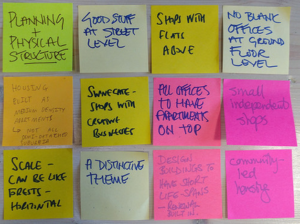
Economy and work
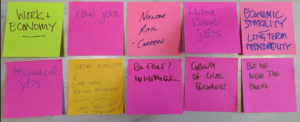
The Circular Economy
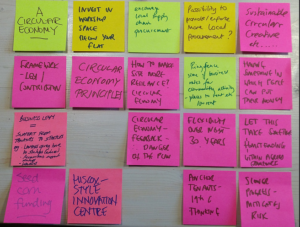
There should be an emphasis on conections – but certain kinds of connections:
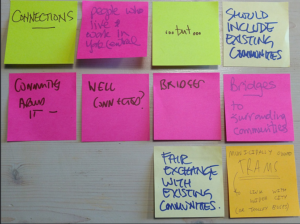
Place where community happens
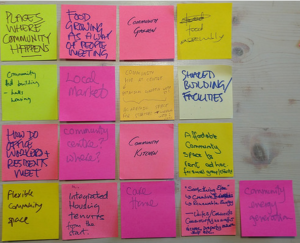
Partnership – should include the community having a ‘seat at the table’
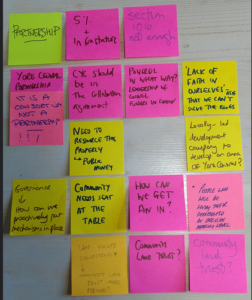
The links that start to make things happen
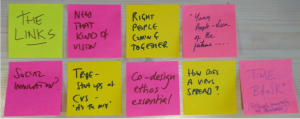
And where do we start?
